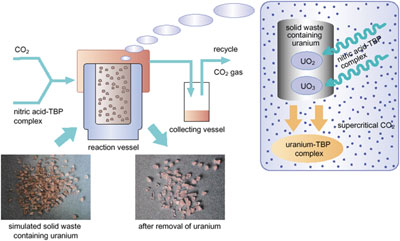For some time now, chemical methods based on the dissolution of uranium compounds with nitric acid have been available for the removal of uranium from solid waste. These methods, however, suffer from the drawbacks that the removal is inefficient or that a large amount of secondary waste is generated. In order to overcome these limitations we have developed a novel and promising method called the Supercritical Carbon Dioxide Fluid Leaching (SFL) Method. This method is based on the dissolution of uranium by means of a supercritical carbon dioxide medium which has properties intermediate between those of liquid and gaseous carbon dioxide (Fig. 4-16).
Solid waste containing uranium oxide is placed in a reaction vessel of the SFL apparatus into which carbon dioxide is introduced. When the vessel is heated to 50 - 60 degrees cent. at a pressure of 100 - 200 atmospheres, the carbon dioxide enters a supercritical state which possesses the capability of dissolving substances. The addition of a small quantity of a complex of nitric acid and tributyl phosphate (TBP) to the supercritical carbon dioxide enables us to transform the uranium contained in the solid waste into the form of a uranium-TBP complex. The uranium-TBP complex is transferred, together with the carbon dioxide solvent, to a collection vessel, where the complex is recovered by gasification of the carbon dioxide at atmospheric pressure and temperature. The results of tests on simulated solid waste, which was a mixture of uranium oxide and sand, demonstrated that the efficiency of removal and recovery of uranium was high enough so that the uranium content could be reduced to from 1/300 to 1/10000 of its initial level in the simulated sample.
The carbon dioxide as well as the nitric acid-TBP complex can be easily recovered and reused, and thus the amount of secondary waste can be minimized. Since the solid waste after treatment does not contain an appreciable amount of moisture or chemical reagents, the procedure for repeated waste treatments can be simplified. |

